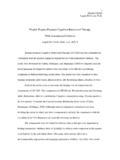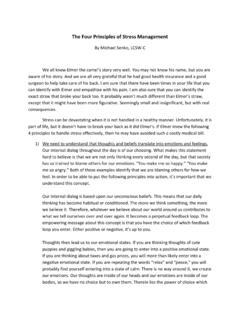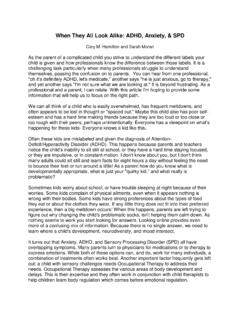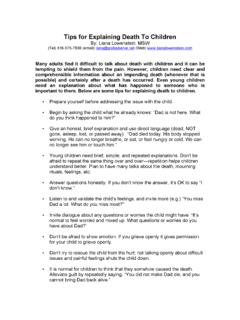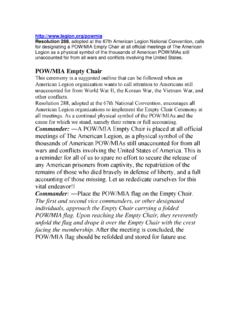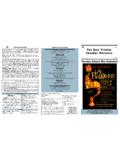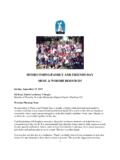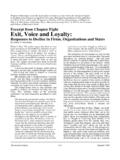Transcription of Creative Interventions for Children of Divorce
1 Creative Interventions for Children of Divorce By: Liana Lowenstein, MSW (Web) (email) Many Children are referred to therapy to help them adjust to Divorce . They typically feel vulnerable and overwhelmed by conflicting emotions. They may feel anxious about the therapeutic process and be reluctant to talk directly about the Divorce . Activities that are Creative and play-based can engage Children and help them to safely express their thoughts and feelings. The purpose of this article is to provide practitioners with Creative therapy techniques for Children of Divorce . In order to effectively treat Children of Divorce , a number of key issues need to be addressed, including developing effective coping skills, facilitating the appropriate expression of feelings, clarifying Divorce -related misconceptions, expressing anger through appropriate outlets, disengaging from parental conflict, eliminating self-blame for the Divorce , and enhancing positive perceptions of self.
2 The Interventions described below aim to address these key treatment domains. Interventions Children of Divorce experience many different feelings, and often have distorted beliefs related to the Divorce . The Basketball Game (adapted from Lowenstein, 2006) helps Children to appropriately express feelings related to the Divorce and clarifies Divorce -related misconceptions. The instructions are as follows: Take turns shooting a basket. If you successfully throw the ball through the basketball hoop, you get two beads or Lego s. If you miss the basket, answer a question (the questions are related to Divorce ). Players earn four beads or Lego for each question correctly answered. At the end of the game, players create something from the beads/Lego s accumulated. Examples of Game Cards include: (1) What are some feelings Children of separated/divorced families often experience?
3 Sad, scared, abandoned, worried, angry, guilty, embarrassed, relieved. (2) What are some reasons parents Divorce ? They were fighting a lot and couldn t make up; they couldn t fix their problems; they weren t happy being together anymore; they fell in love with someone else; they stopped being in love. (3) What are some reasons why Children may blame themselves for their parents Divorce ? They may think they made their parents argue and that s why they got divorced. Or they may think they should have done something to make their parents stay together. But Divorce is never a child s fault. (4) True or false: Once parents Divorce they hardly ever get back together. 2 True. Once parents Divorce it is usually forever. (5) True or false: Children must pick sides and love one parent more than the other.
4 False. Children don t have to pick sides; they can love both their parents. A central goal in therapy is to help Children develop awareness of internal emotional states and to be able to appropriately label what they are feeling. Guess Which Hand (Lowenstein, 2014) is a fun game that builds the child s emotional vocabulary and encourages feelings expression. The practitioner writes a feeling word ( , happy) on a small piece of paper, folds it several times to form a paper clump, and places it in one hand. The practitioner puts her hands behind her back, moves the feeling word from hand to hand a few times, then places both closed hands in front of her. The client tries to guess which hand is holding the feeling word. If the client guesses the correct hand, both the client and the practitioner take turns telling a time they experienced the feeling.
5 The client earns a point for telling about the feeling, plus a bonus point for guessing the correct hand. (If the client did not guess correct hand, then the client still earns one point for telling about the feeling.) The client can earn a bonus point for showing with face and body what the feeling looks like. The game is repeated several times with new feeling words added for each round. If desired, the client can be awarded a small prize once ten points are earned. Utilizing a variety of engaging Interventions helps Children strengthen affective expression skills. There are many Creative techniques in the literature from which to choose. Click! Emotions (Cotnoir, 2008), Feelings Tic-Tac-Toe (Lowenstein, 1999), and Lego Emotion House (Grant, 2016) are fun activities that encourage the expression of emotions.
6 Parental conflict in Divorce has damaging effects on Children (Amato, 2001; Garrity and Barris, 1994; Johnston and Roseby 1997; Sarrazin and Cyr, 2007). Effective intervention with high-conflict families must involve an integrated family therapy approach, such as the one outlined by Lebow and Rekart (2006). Helping Children to appropriately disengage from parental conflict is an important part of a multifaceted approach. An engaging technique that can be used with Children is called My Parents Argue and I Feel Stuck in The Middle Marshmallow People (Lowenstein, 2006). The activity begins by having the child complete the following sentences: (1) My parents argue (2) When my parents argue, I (3) My mom says mean things to my dad, (4) My dad says mean things to my mom, The practitioner then instructs the child as follows: Make three marshmallow people to represent you, your mother, and your father (use marshmallows for the head and body and pretzel sticks for the arms and legs).
7 Use the marshmallow people to act out an argument you saw between your parents. 3 Use the marshmallow person that represents you to practice going into another room when your parents are arguing. When your parents are arguing, it can help to tell yourself: When my parents argue, they still love me, no matter what! Use your marshmallow person to practice saying this to yourself. After the activity, the child can eat one of the marshmallow people! Many Children blame themselves when parents Divorce . Getting Rid of Guilt (adapted from Lowenstein, 2006) is an intervention to challenge and correct distorted thoughts regarding self-blame. The child uses dolls or action figurines to role-play scenarios. In each scenario, a child (represented by a doll or figurine) makes a guilt-ridden statement, and another child (represented by a doll or figurine) responds with an appropriate challenge to that guilty statement.
8 For example, the guilty child/figurine says, I should have been able to save my parents marriage. The helper child/figurine responds, It s not up to kids to fix their parents marriage. In another scenario, the guilty child/figurine says, I was bad so that s why my parents split up. The helper child/figurine responds, Your parents split up because they could not live happily together anymore. This activity helps Children provide accurate attributions for parental problems, which leads to better adjustment in Children (Pedro-Carroll & Alpert-Gillis, 1997, Stolberg & Mahler, 1994). Helping Children express feelings of anger about the Divorce through appropriate outlets is another important treatment goal. In the Feeling Angry Play Dough Pounding activity (Lowenstein, 2006) Children make their own play dough, then pound it to release their emotions.
9 Then they complete sentences, such as, I am angry about my parents Divorce and It s not fair Children then learn and practice several techniques for the safe expression of anger. The Don t Flip Your Lid Anger Management Program (Lowenstein, 2002) is an intervention that teaches strategies for appropriately expressing anger. Studies indicate that active coping that includes problem solving and positive thinking enhances resilience among Children (Sandler, Tein, & West, 1994; Sandler, Tein, Mehta, Wolchik, & Ayers, 2000). The Coping with Divorce Game (adapted from Lowenstein, 2006) facilitates this treatment goal. In the game, Children must choose solutions to typical problems that Divorce often poses, for example: (1) William s parents tell him mean things about each other. Circle the best way for him to cope with this problem: (a) He should agree with his parents when they tell him mean things about each other (b) He should politely say, Please stop saying mean things about each other (c) He should blast the radio to drown out anything his parents say 4 (2) Robbie thinks he is to blame for his parents Divorce because he was always getting into trouble and his parents were always fighting about him.
10 Circle the best way for him to cope with this problem: (a) He should feel guilty for causing the Divorce (b) He should act perfect so his parents will love him (c) He should tell himself his parents didn t Divorce because of anything he said or did (3) Brad does not like his father's girlfriend and he is jealous of the time his father spends with her. Circle the best way for him to cope with this problem: (a) He should be mean to the girlfriend so she will stay away (b) He should talk to his father about how he feels (c) He should refuse to see his father until he dumps his girlfriend Interventions that help Children identify their unique strengths further facilitates Children s healthy adjustment. In the Positive Postings activity (Swank, 2008), the practitioner asks the client to think about positive qualities about her/himself and to write each one on a Post-it Note.


